Thanks to its Eurasian connections, the Tsardom of Russia (1547-1721) and its successor the Muscovy-Romanov Empire (1721-1917) experienced the Buddhist diffusion earlier than many other early modern empires, including the Ottoman, British, and Mughal empires. This unique presence of Buddhism persists today through the nomadic cultures of Kalmyks, Buryats, Tuvans, and other minorities in the Federation. We are grateful to Dr. Andrey Terentyev for publishing this four-part series about Russian Buddhism with us.
Vajrayana Buddhism first spread to Russia in the seventeenth and eighteenth centuries, when the nomadic Mongol tribes of Oirats (present-day Kalmyks) and Buryats migrated to the lower reaches of the Volga and to the east of Lake Baikal. Much later, another mass of Buddhists joined Russia when the tsarist government annexed Tuva, a region west of Lake Baikal and north of Mongolia. Although the Buryats, Kalmyks, and Tuvans all shared a common religion, Buddhism evolved independently within each group. The results were distinct national systems of monasteries (Buryat datsans, Kalmyk khuruls, and Tuvan khure) and separate national ecclesiastical structures.
Buddhism had been known among the western Mongolian Oirat tribes of Derbets and Torguts since the thirteenth century, but it did not become widely practiced until the beginning of the seventeenth century. During the second half of that century these tribes migrated to the region of the lower Volga and Don, created the Kalmyk khanate, and made Buddhism its official religion. The Oirats arrived on Russian territory more than 400 years ago with nomadic monasteries (khuruls) consisting of three or more tents. Sedentary monasteries quickly began to appear. One of the earliest was Darkhan-Dorzhin-kit, or Seven Chambers. It was built before 1616 in the region of present-day Semipalatinsk. Others followed, including Ablain-kit (1656), Botoktukhan-kit (1670), Dzhalin-obo, Ohirtukhan-kit, and Tsagan-sume.
In 1771, as a result of persecution by the tsarist government, the bulk of the Kalmyks fled back to Dzungaria (in present-day China). The 13,000 families of Kalmyks who remained in Russia were resettled along the Ural, Terek, and Kuma rivers. Not counting the khuruls that migrated out of Russia in 1771 with the mass of the Kalmyk people, by the end of the eighteenth century fourteen Buddhist monasteries remained among the Kalmyks.
Religious leaders among the Kalmyks were called lamas, while the remaining religious individuals – monks and those studying to become lamas – were khuvaraki (singular khuvarak). After the out-migration of 1771 the Buddhist church was decentralized and each region (ulus) chose its own head lama. There were three ranks of khuvaraki: mandzhi, getsul, and geliung. Since the beginning of the eighteenth century advancement through these ranks was controlled by a system of monastic education: a young mandzhi would study for five years to reach the first monastic rank of getsul, after which eight more years of education would be required to reach the rank of geliung. Finally there would be five to seven more years of study, generally completed by the age of thirty.
FEATURES|VEHICLES|Vajrayana
A History of Buddhism in Russia: The Early Centuries
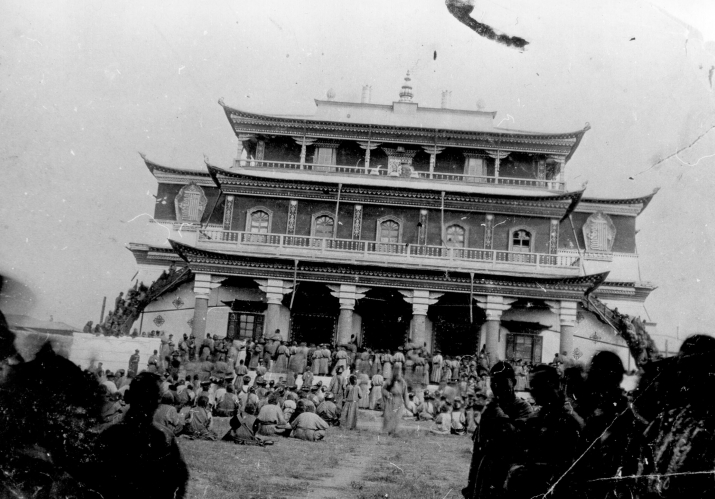 Tsugolsky datsan of Buryat, 1906.
Tsugolsky datsan of Buryat, 1906.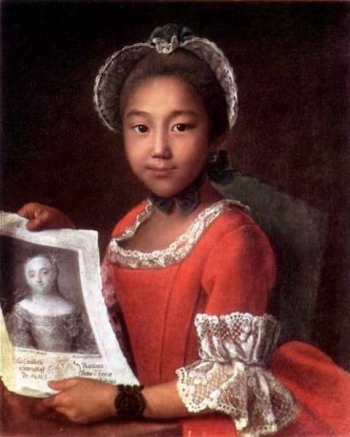 Portrait of a Kalmyk girl, by Ivan Argunov. From wikpedia.org.
Portrait of a Kalmyk girl, by Ivan Argunov. From wikpedia.org.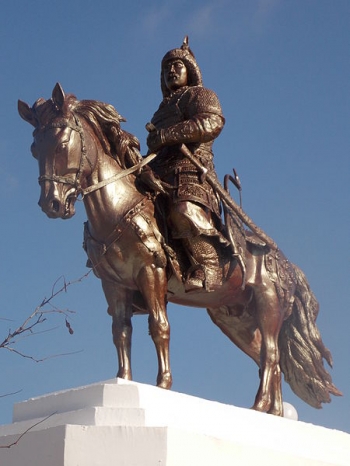 Under Ubashi Khan, almost 200,000 Kalmyks fled from the Volga's pastures to Dzungaria. From Wikipedia.
Under Ubashi Khan, almost 200,000 Kalmyks fled from the Volga's pastures to Dzungaria. From Wikipedia.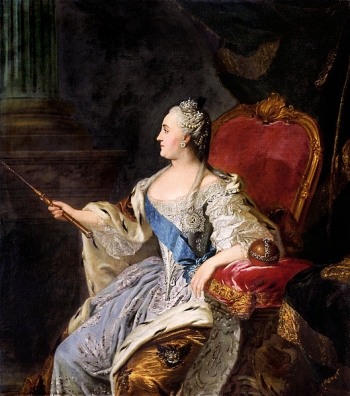 After the flight, Catherine the Great abolished the Kalmyk Khanate. The title of Khan was abolished, with the Vice-Khan chosen by Russia. The tsarists now exercised complete control. Portrait by Fyodor Rokotov.
After the flight, Catherine the Great abolished the Kalmyk Khanate. The title of Khan was abolished, with the Vice-Khan chosen by Russia. The tsarists now exercised complete control. Portrait by Fyodor Rokotov.Among the Kalmyks we find a legal system requiring universal compulsory education for boys for perhaps the first time in world history. This is prescribed in section seven of the second chapter of the law code promulgated in the reign of khan Dondok-Dashi (1741-1753):
"If any of the sons of the noble people shall not be taught reading and writing in todo ueeg [the Oirat alphabet], then the father shall pay a three-year-old horse as a fine and the son shall be given to a teacher for instruction. The fine for the same offense from a person known to society: a three-year-old sheep. From a commoner: fifteen kopecks*, and the son is given to instruction just as in the above situation. If he does not educate his son before age fifteen, he will be punished for this."
Buddhism diffused into the area east of Lake Baikal at around the same time. The first reports of Buddhist beliefs among the Buryats come from Moscow in 1647 (by the Cossack captain K. Moskvitin). By 1741, eleven temples and 150 Tibetan and Mongolian monks were registered in Transbaikalia. Agvan Puntsok, a Tibetan from Chone, was the head lama. Historians frequently cite a decree of Empress Elizabeth from 1741 as officially recognizing Buddhism in Russia, but so far we have been unable to discover evidence of this decree among the collections of state documents.
The first Buryat temples (sume) were composed of yurts and traveled along with their nomadic parishioners. Not until approximately 1753-58 did the first wooden Buddhist temple begin to be built – the Tsongol datsan (later called Khilgantuivskiy). The head of the monastery was Damba Darzha Zayaev (1711-77), an aide and disciple of Agvan Puntsok.**
The wooden buildings of Gusino-ozero (Goose Lake) datsan were probably built a little later. It was founded by Lubsan Zhimba Akhaldaev, who had been educated in Tibet.
A rivalry between these two Buryat monastic centers started and continued up to the beginning of the 19th century, at which time the tsarist administration recognized the priority of the Goose Lake datsan. The head of that monastery was given the title bandido khambo lama of all Buryat datsans. The title consists of a Mongolized pronunciation of Sanskrit pandita meaning learned and Tibetan khenpo-lama, meaning head lama.
By 1846, 144 buildings in 34 monasteries had been built in Buryatia, and the number of clergy was increasing rapidly. While there were just 150 lamas*** in 1741, by 1796 there were 700, and in 1831 there were 4,637.
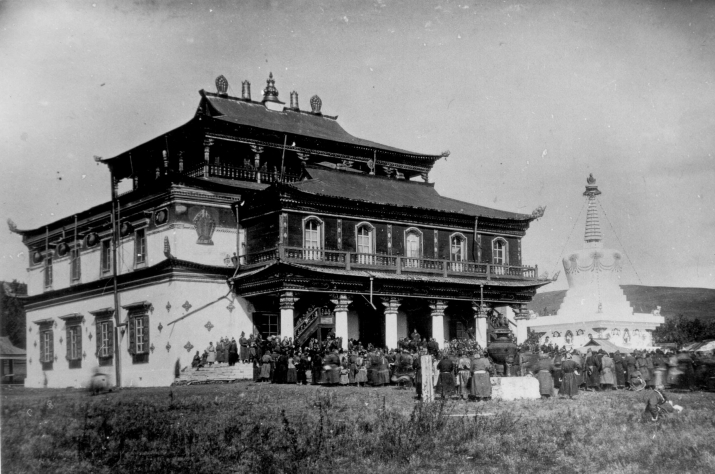 Aginsky datsan in Buryatia, 1914.
Aginsky datsan in Buryatia, 1914.The Russian government tried to put a stop to the development of Buddhism among the Buryats as part of its efforts to facilitate the Christianization of the region. In 1853 it forbade the building of new datsans other than the already existing 34 in a law titled Regulation Concerning Lamaist Clergy in Eastern Siberia. It also attempted to limit the growth of the number of lamas by stipulating that only one lama per 200 parishioners would be tax-free. This would have resulted in a limit of 285 established lamas, and the remaining thousands of clergy would be taxed just like ordinary peasants. As a practical matter, however, the 1853 law was not actively enforced because the government had plans for expansion in East Asia and was afraid of stirring up too much dissatisfaction among the population of this key region. And so Buryat Buddhism continued its rapid growth.
This growth was facilitated by the establishment of a system of uninterrupted Buddhist education. After the appearance in Buryatia of Buddhist faculties of tsannit (philosophy), completion of such a course of studies became obligatory for the clergy of datsans. The base curriculum lasted for fourteen years, beginning after two years of primary education. It included the following themes: fundamental theories of knowledge and logic in the third and fourth years; the system of Buddhist paths of development (paramita) in the fifth through ninth years; in-depth study of the teaching of emptiness (madhyamaka) in the twelfth and thirteenth years; and an introduction to monastic discipline (vinaya) in the fourteenth year. The fourteenth year was not the end, for a complete course of study in monastic discipline would take eight years. Those who completed the entire program took exams leading to the rank of gabzha, equivalent to a doctorate.
In addition, a person who completed the tsannit program could go on to study in the tantric program. In Buryat tantric datsans after ten years one could receive the title of zhedrimba, i.e., attain the first of two ranks of perfection on the scale of Vajrayana. Ten more years after that were required to receive the rank of zogrimba which signified complete mastery of the techniques of meditative control of energies and channels. This highest level of perfection was given the honorary title of Dorzhezinba (Sanskrit: Vajradhara).
The Buryats expended a tremendous amount of effort and material resources in order to import a mass of treasured literature from Tibet, China, and Mongolia, and to adopt many living traditions from Tibetan Buddhism. One of these traditions was Tibetan medicine. In 1869 in the Tsugol datsan the official teaching of Indo-Tibetan medicine began (it had been practiced informally since the eighteenth century). By the end of the nineteenth century it had attained such success that doctors of Tibetan medicine Tsul'tim (Aleksandr) Badmaev (d.1873) and his younger brother Zhamsaran (Petr) Badmaev (1810-1920) traveled to St. Petersburg and treated famous people and even the imperial family.
In 1878 in the Aginsk datsan the Kalachakra school was founded, marking the final stage in the building of a system of higher education following the Tibetan model.
Book printing and publishing developed quickly. In 1887 there were already twenty-nine publishing houses, which together managed to publish around 2,000 titles in the Tibetan and Mongol languages until their demise under the Communists in the 1930s.
* A 'kopeck' is 1/100 of a Russian ruble. – A.T.
** We can refer here to the funny recent claim of the present Buryat Head Lama Ayusheev, who says that Buryats received the Dharma not from Tibetans, because the 1st Buryat Khenpo Zayaev received the Teachings in his first incarnation from the Buddha Kashyapa, and in his 2nd incarnation – from the Buddha Shakyamuni (see http://savetibet.ru/2008/03/26/ayusheev.html).
*** In Buryatia all those who dwell within the monasteries, even before full gelong ordination, are named 'lamas'.
See Our Full Series of A History of Buddhism in Russia
The Early Centuries
Tensions with the Tsars
The Sangha and the Soviets
Return to Saint Petersburg














